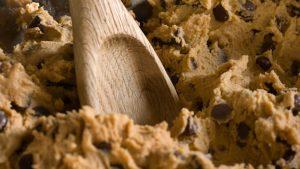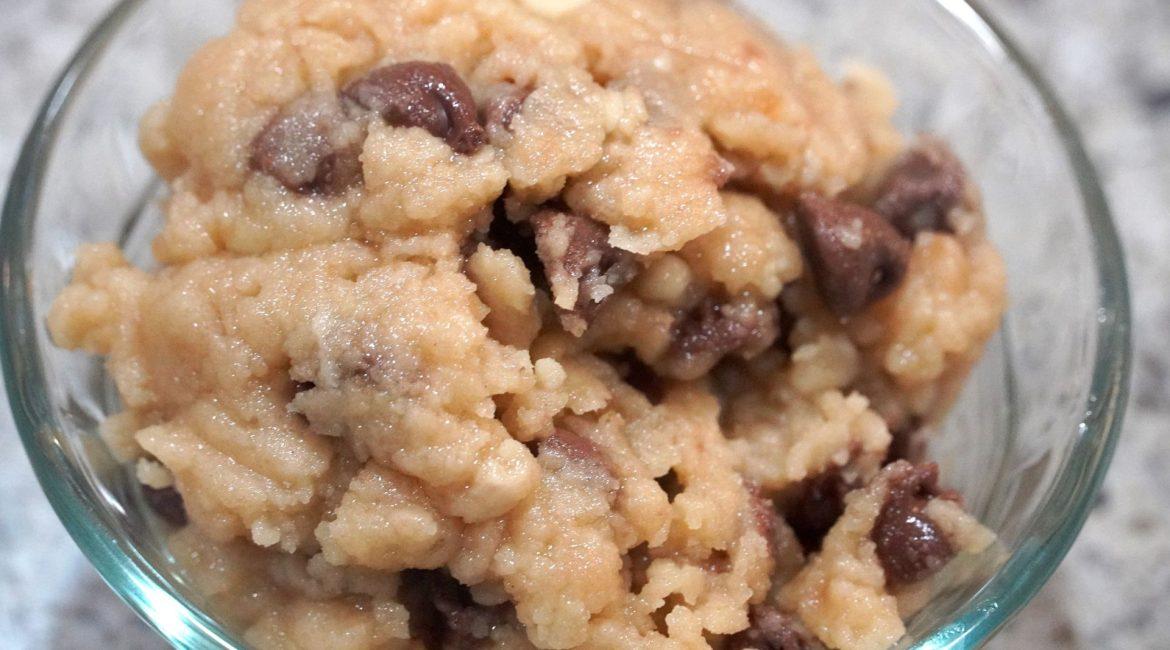Hey there, cookie lovers! If you’ve ever wondered whether or not you should chill your chocolate chip cookie dough before baking, you’re in the right place.
In this blog post, we’re going to dive into the age-old debate of chilled vs. unchilled dough and uncover the delicious science behind both options.
So, grab a glass of milk, and let’s settle the doughy dilemma! 🍪🥛
Chocolate chip cookie dough needs to be chilled: Is this true?
Yes, chocolate chip cookie dough typically benefits from being chilled before baking, but it’s not always strictly necessary.
Chilling the dough has several advantages.
Here is the thing:
Flavor development: Chilling allows the ingredients to meld together, enhancing the flavor of the cookies.
This is because the fats in the dough (usually butter) have time to solidify, which can improve the overall taste.
Texture improvement: Chilled dough tends to spread less during baking, resulting in thicker and chewier cookies.
It also helps to prevent cookies from becoming too thin and crispy.
Reduced spreading: Chilled dough is less likely to spread excessively in the oven, which can help maintain the shape of the cookies and prevent them from sticking together.
Time-saving: Chilling the dough in advance can save time when you’re ready to bake because you can scoop or slice the dough into cookies and bake them immediately.
However, if you’re in a hurry or don’t have the patience to chill the dough, you can still make perfectly good chocolate chip cookies.
They might spread a bit more during baking, resulting in thinner cookies, and the flavor might not be as well-developed, but they will still be tasty.
If you do choose to chill your dough, it’s recommended to refrigerate it for at least 30 minutes to an hour.
Some recipes even call for overnight chilling, which can yield even better results in terms of flavor and texture.
Ultimately, whether or not to chill your chocolate chip cookie dough depends on your preference and the time you have available, but it can certainly be worth the wait for a superior cookie.

Let’s dig deeper and Further the Explanations here.
Let’s delve deeper, let me explain these points mentioned further.
First let me dive deeper into how chilling chocolate chip cookie dough enhances flavor through the solidification of fats, particularly butter:
Flavor development.
Fat Solidification:
In chocolate chip cookie dough, one of the primary sources of fat is butter. At room temperature, butter is in a semi-solid state, with its fats partially melted.
When you mix softened butter into the dough, it disperses evenly, but it’s still relatively soft.
Flavor Absorption:
The various ingredients in the cookie dough, including sugars, vanilla extract, and the chocolate chips, contain flavorful compounds.
When the dough is initially mixed, these flavorful compounds are dispersed throughout the dough.
Chilling Process:
When you chill the dough, especially for an extended period, the butter in the dough solidifies due to the lower temperature of the refrigerator.
As butter solidifies, it traps the flavorful compounds from the other ingredients within its structure.
Melding of Flavors:
The solidified fat acts like a matrix, capturing and preserving the volatile flavor compounds from the other ingredients.
This melding or “marrying” of flavors occurs as the dough rests in the cold environment.
Flavor Development:
Over time, as the dough chills, the trapped flavor compounds interact and blend with each other.
This interaction allows for a more harmonious and balanced distribution of flavors throughout the dough.
It also allows certain chemical reactions to take place, such as the Maillard reaction, which contributes to a richer and more complex flavor profile.
Enhanced Aroma:
Additionally, chilling the dough can intensify the aroma of the cookies.
As the dough rests, the volatile flavor compounds are less likely to evaporate, resulting in a more fragrant and aromatic cookie dough.
In other words, when chocolate chip cookie dough is chilled, the fats, especially butter, solidify and act as a flavor reservoir, capturing and enhancing the taste of the other ingredients.
This melding and interaction of flavors during the chilling process contribute to the overall improvement in the flavor of the cookies when they are baked, making them more delicious and satisfying.
Texture improvement.
let’s explore how chilling chocolate chip cookie dough contributes to texture improvement, resulting in thicker, chewier cookies while preventing them from becoming too thin and crispy:
Butter Solidification:
As mentioned earlier, chilling the cookie dough causes the butter to solidify.
This solidification means that when the cookies are placed in the hot oven, the solid butter takes longer to melt compared to room temperature dough.
Delayed Spreading:
The solidified butter in chilled dough doesn’t melt and spread as quickly during baking.
This slower melting process allows the cookies to hold their shape for a longer time in the oven.
As a result, the cookies spread less, and they remain thicker and more compact.
Chewier Texture:
Thicker cookies tend to have a chewier texture because they have a higher ratio of dough to surface area.
This means that the interior of the cookies stays softer and moister, creating a pleasing chewiness that many people enjoy.
Preventing Over-Crispiness:
When cookie dough spreads excessively during baking, it can result in thin, crispy cookies.
Chilled dough, by spreading less, helps prevent the cookies from becoming overly thin and crispy.
Instead, they maintain a more balanced texture, with a crisp exterior and a chewy interior.
Uniform Baking:
Cookies made from chilled dough also tend to bake more evenly.
Since they spread less, the center and edges of the cookies are less likely to overcook or undercook, ensuring a consistent texture throughout.
Customizable Texture:
Chilling the dough allows you to have more control over the final texture of your cookies.
If you prefer your cookies thinner and crisper, you can use room temperature dough.
But if you want them thicker and chewier, chilling the dough is the way to go.
In essence, chilling chocolate chip cookie dough slows down the spreading of cookies during baking, resulting in a thicker, chewier texture while avoiding excessive thinness and crispiness.
This texture enhancement is one of the reasons why many cookie recipes recommend chilling the dough before baking to achieve the desired cookie characteristics.
Reduced spreading.
let’s explore how chilling chocolate chip cookie dough reduces spreading during baking, helping to maintain the shape of the cookies and preventing them from sticking together:
Butter Solidification:
When cookie dough is chilled, the primary source of fat, typically butter, becomes solid.
At lower temperatures, butter has a more solid and stable structure compared to its soft and semi-liquid state at room temperature.
Spreading Mechanism:
During baking, as the dough heats up, the fats within it begin to melt.
The melted fats act as a lubricant, allowing the dough to spread.
This spreading is a natural reaction to the heat and contributes to the flat shape of baked cookies.
Slower Spreading:
Chilled dough contains solidified fat, which takes longer to melt and turn into a lubricating liquid during baking.
As a result, the dough spreads more slowly and to a lesser extent compared to dough made with room temperature butter.
Maintained Cookie Shape:
The reduced spreading of the chilled dough helps the cookies maintain their intended shape.
This is particularly important when you’re aiming for well-defined, round, or shaped cookies, such as traditional chocolate chip cookies.
Without chilling, the cookies can spread excessively, becoming thin and losing their shape.
Preventing Sticking Together:
When cookies spread too much during baking, they may run into each other on the baking sheet. This can lead to cookies merging together, forming one large, irregular mass.
Chilled dough’s reduced spreading minimizes the chances of cookies sticking together, as they maintain more distinct boundaries during baking.
Enhanced Appearance:
Cookies made from chilled dough often have a more appealing appearance because they hold their shape better.
This can be important for presentation, especially if you’re baking cookies for a special occasion or as gifts.
Overall, chilling chocolate chip cookie dough helps maintain the shape of the cookies during baking by slowing down the melting of fats and reducing excessive spreading.
This not only contributes to the cookies’ appearance but also prevents them from sticking together on the baking sheet, resulting in individual, well-formed cookies with a consistent shape.
Time-saving.
let’s delve into how chilling chocolate chip cookie dough in advance can save time when you’re ready to bake by allowing for immediate scooping or slicing:
Preparation Efficiency:
When you prepare chocolate chip cookie dough, it often requires mixing various ingredients, such as flour, sugars, eggs, and chocolate chips.
This mixing process can be a bit time-consuming, especially if you’re aiming for a uniform and well-incorporated dough.
Chilling Streamlines the Process:
Chilling the dough in advance streamlines the baking process. Here’s how:
Firm Texture:
Chilled dough is firmer and easier to work with than dough at room temperature.
It holds its shape well, making it easier to scoop or slice into evenly sized portions.
Reduced Stickiness:
Chilled dough is less sticky, which means you can handle it more easily without it sticking to your hands, utensils, or the cookie scoop.
Ready-to-Bake Convenience:
By chilling the dough in advance, you can essentially prepare the dough up to a certain point and then store it in the refrigerator until you’re ready to bake.
This means you can have cookie dough on hand and ready to go whenever you want to bake a batch of cookies.
Flexible Timing:
Chilled cookie dough is quite forgiving in terms of timing. You can chill it for a short period, such as 30 minutes to an hour, or for longer, even overnight.
This flexibility allows you to work with your schedule and bake cookies when it’s most convenient for you.
Consistency in Cookie Size:
When you scoop or slice chilled dough, you can ensure that each cookie is of uniform size and shape.
This consistency is important for even baking, so you don’t end up with some cookies undercooked and others overcooked.
Minimized Wait Time:
Since you’ve already prepared the dough and it’s chilled, there’s no need to wait for it to come to room temperature or deal with overly soft dough.
You can simply portion out the dough and bake right away, saving you time and reducing the overall baking process.
In summary, chilling chocolate chip cookie dough in advance can be a time-saving strategy because it allows you to prepare the dough when you have the time and then have it ready to scoop or slice and bake immediately when you’re ready.
This convenience makes the entire baking process more efficient and flexible to fit your schedule.
A compare tabular on this topic here.
Here’s a comparison table highlighting the key points regarding whether or not chocolate chip cookie dough needs to be chilled before baking:
| Aspect | Chilled Cookie Dough | Unchilled Cookie Dough |
|---|---|---|
| Flavor Development | Enhances flavor due to melding of ingredients. | May have slightly less developed flavor. |
| Texture Improvement | Results in thicker, chewier cookies. | Tends to yield thinner and crisper cookies. |
| Reduced Spreading | Spreads less during baking, maintains shape. | Can spread more, potentially losing shape. |
| Prevents Sticking | Less likely to stick together on the baking sheet. | May stick together if cookies spread excessively. |
| Time-saving | Convenient for scooping and baking immediately. | Requires less pre-baking preparation time. |
| Customization | Offers control over cookie thickness and texture. | Limited control over thickness and texture. |
| Aroma Enhancement | Can intensify the aroma of the cookies. | Aroma may be less pronounced during baking. |
Please note that whether or not to chill cookie dough depends on personal preference and desired cookie characteristics.
Chilling can enhance certain aspects like flavor and texture, but unchilled dough can also yield delicious cookies, albeit with different qualities.
Conclusion.
In conclusion, chilling chocolate chip cookie dough before baking enhances flavor, texture, and shape consistency, making it ideal for those seeking thicker, chewier cookies with distinct shapes.
However, unchilled dough can still yield delicious cookies, albeit with slightly different characteristics and less time spent on preparation.
The choice depends on your desired cookie outcome and available time.

Whether you’re a passionate baker or simply seeking sweet inspiration, I’m here to provide you with valuable insights, mouthwatering recipes, expert tips, and more to make your cookie adventures with Mike truly delightful and scrumptious. You are on the true exciting cookie-filled side.





